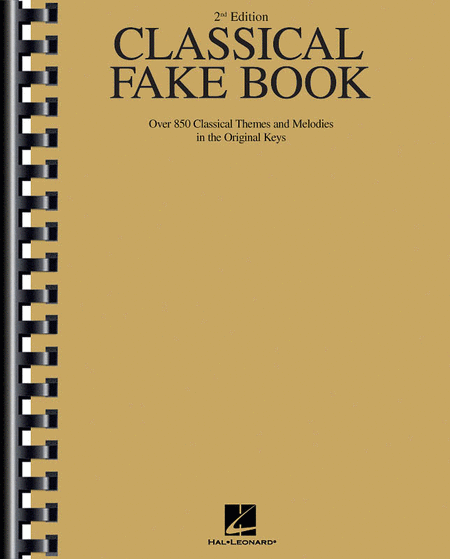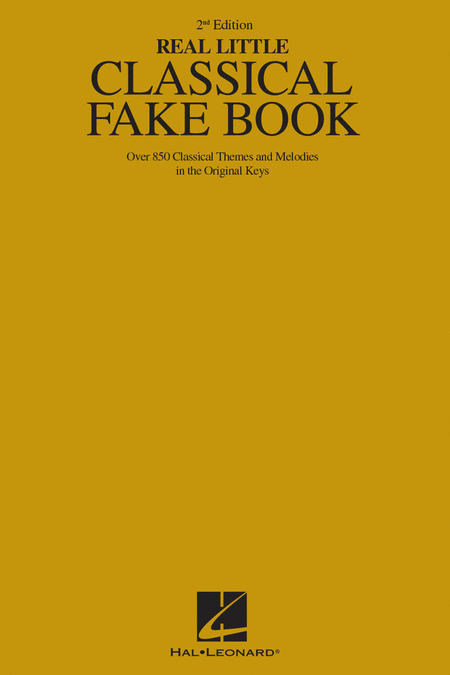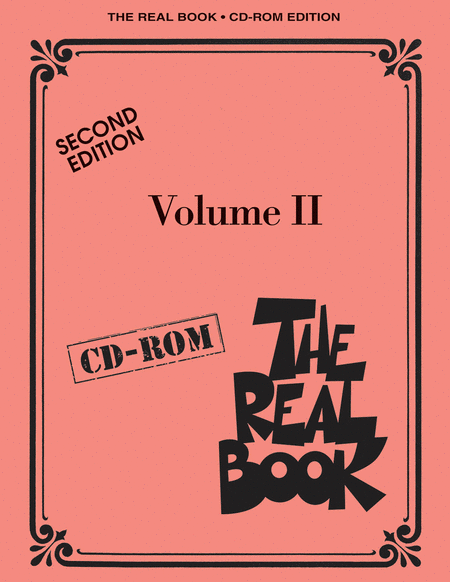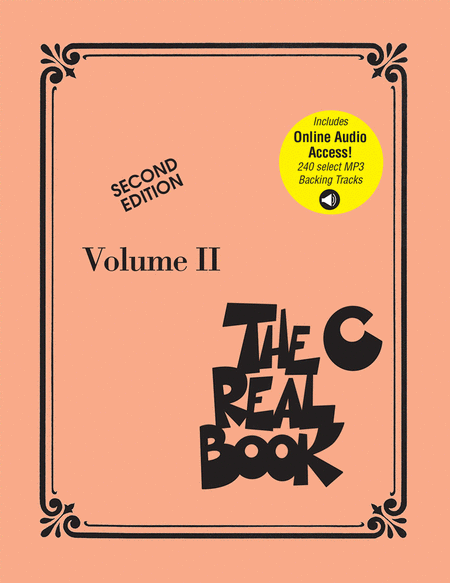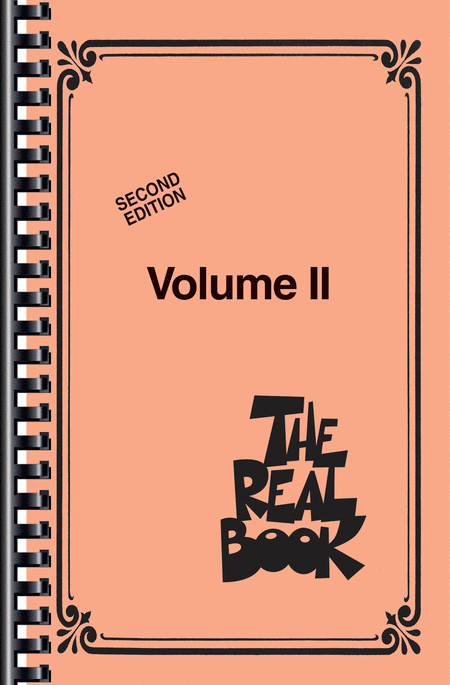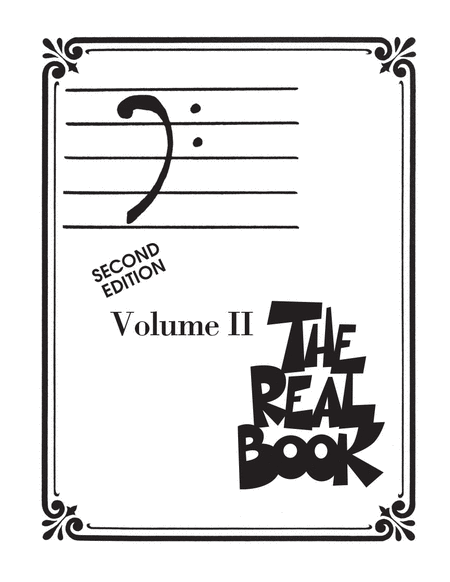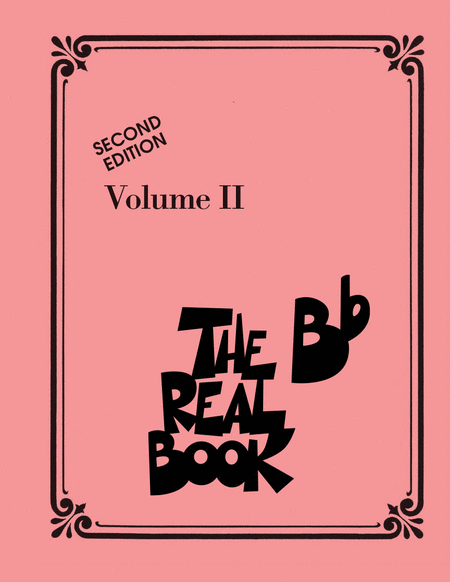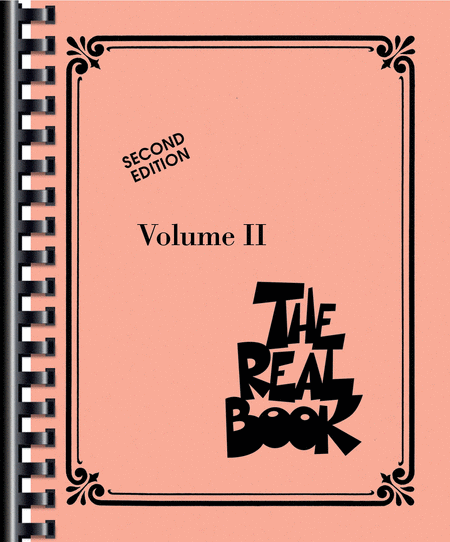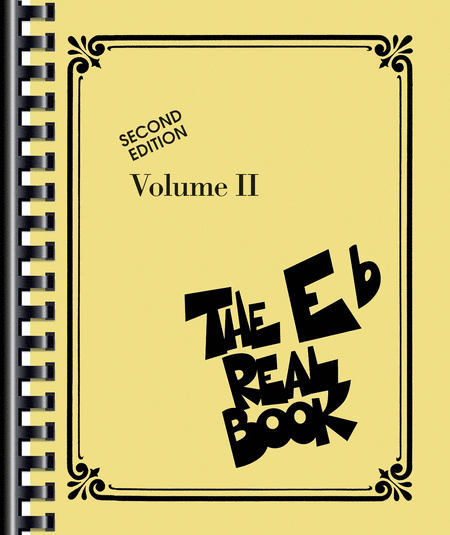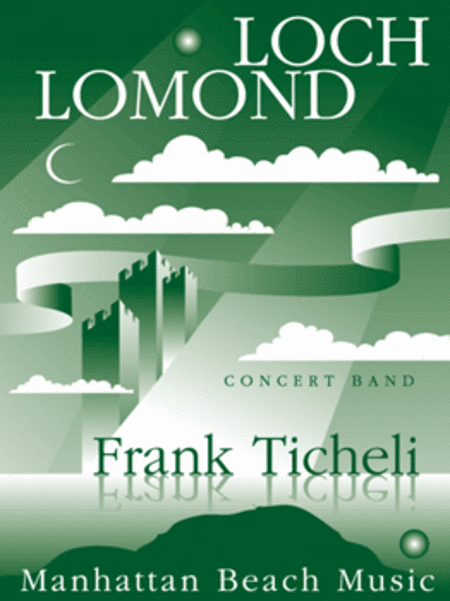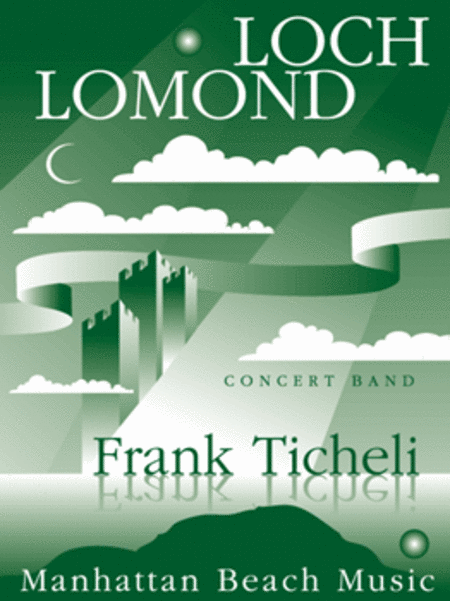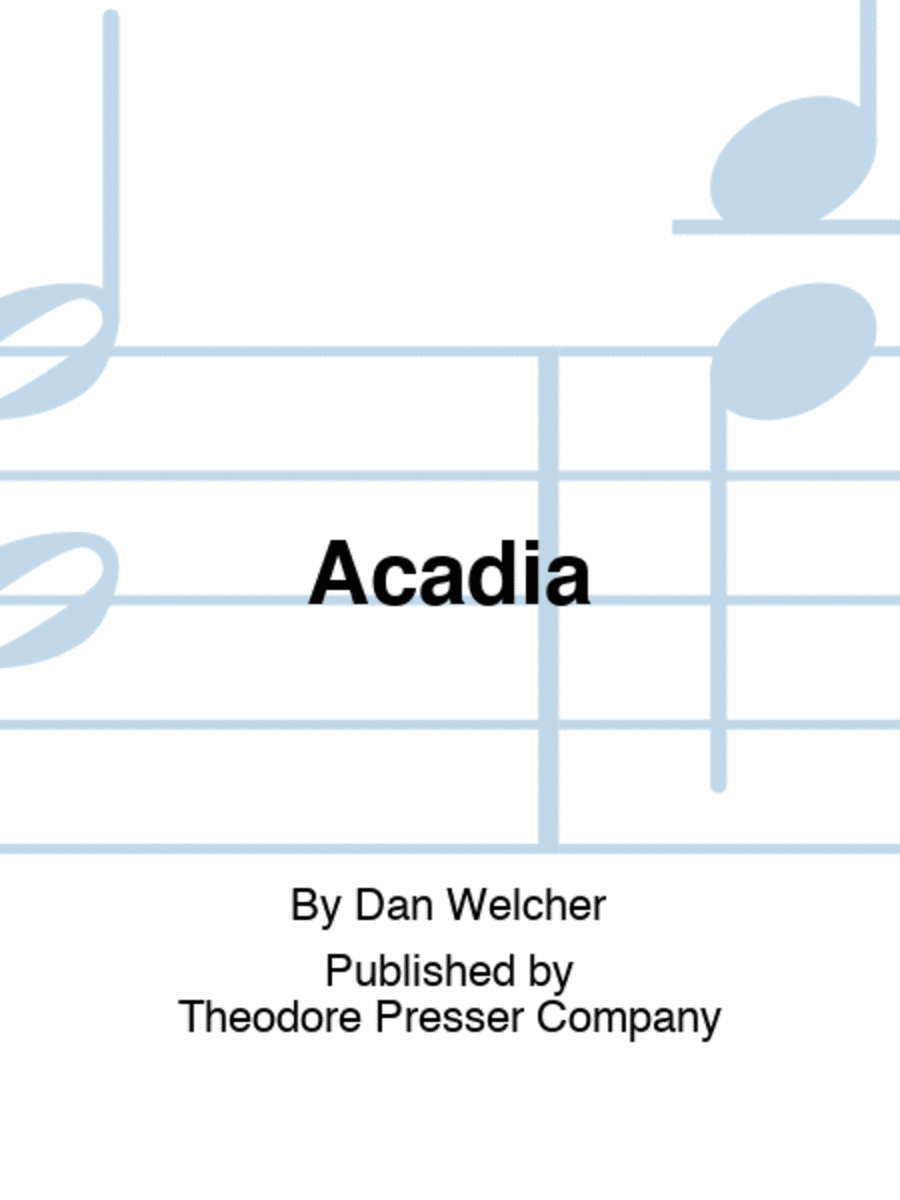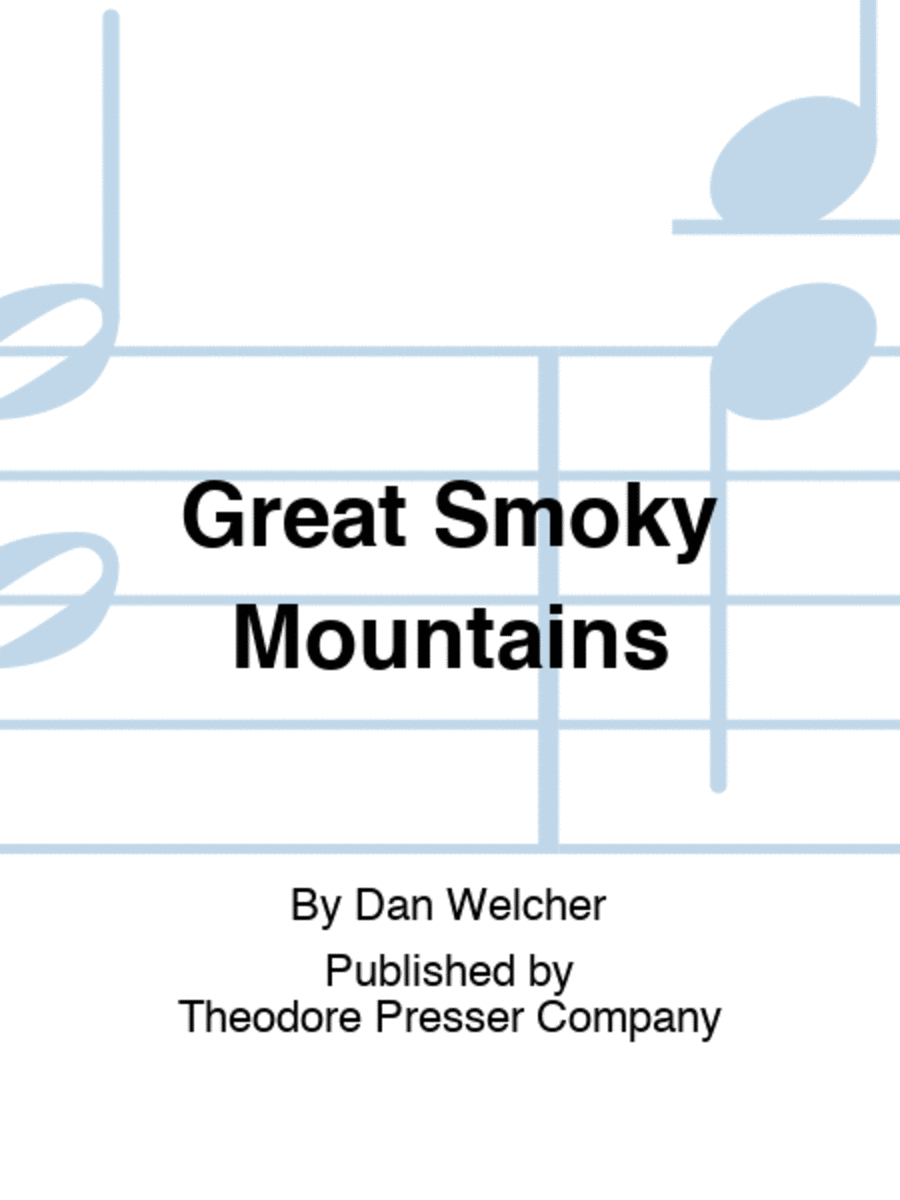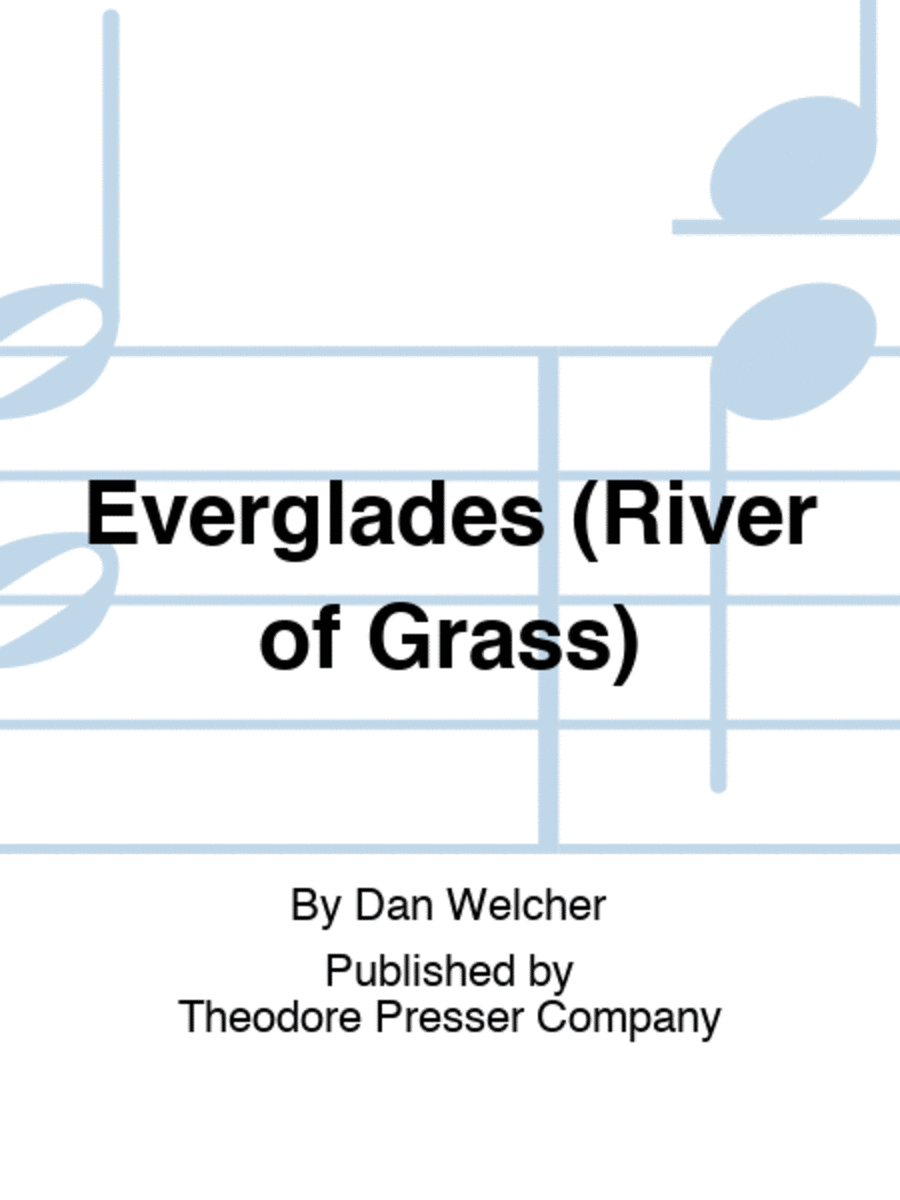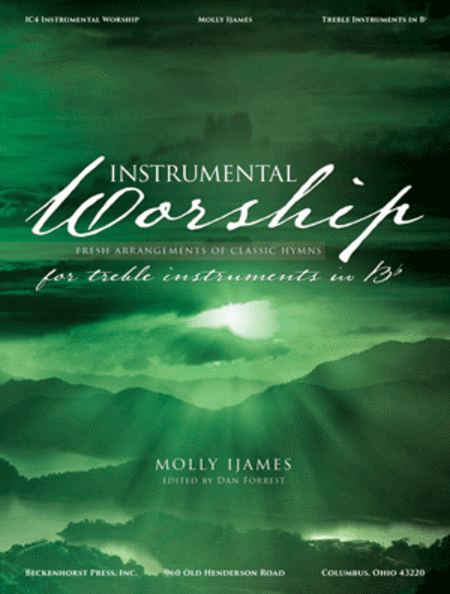|
| Classical Fake Book - 2nd Edition
Fake Book [Fake Book] - Facile
Hal Leonard
(Over 850 Classical Themes and Melodies in the Original Keys) For C instrument. ...(+)
(Over 850 Classical
Themes and Melodies in
the Original Keys) For C
instrument. Format:
fakebook (spiral bound).
With vocal melody
(excerpts) and chord
names. Lassical. Series:
Hal Leonard Fake Books.
646 pages. 9x12 inches.
Published by Hal Leonard.
(8)$49.99 - Voir plus => AcheterDélais: 24 hours - In Stock | | | |
| The Real Little Classical Fake Book - 2nd Edition
Piano seul - Intermédiaire
Hal Leonard
Composed by Various. For Piano/Keyboard. Hal Leonard Fake Books. Classical. Diff...(+)
Composed by Various. For
Piano/Keyboard. Hal
Leonard Fake Books.
Classical. Difficulty:
medium to
medium-difficult.
Fakebook. Melody line,
chord names and lyrics
(on some songs). 413
pages. Published by Hal
Leonard
$27.50 - Voir plus => AcheterDélais: 24 hours - In Stock | | | |
| The Real Book - Volume II - Second Edition CD-ROM
Fake Book [CD-ROM]
Hal Leonard
| | | |
| The Real Book - Volume 2: Second Edition
Instruments en Do [Partition + Accès audio]
Hal Leonard
Book with Play-Along Tracks. Composed by Various. Real Book Play-Along. Softco...(+)
Book with Play-Along
Tracks.
Composed by Various. Real
Book Play-Along.
Softcover
Audio Online. 440 pages.
Published by Hal Leonard
$75.00 - Voir plus => AcheterDélais: 24 hours - In Stock | | | |
| The Real Book - Volume 2 - Mini Edition
Fake Book [Fake Book]
Hal Leonard
C Instruments. By Various. Fake Book (Includes melody line and chords). Publishe...(+)
C Instruments. By
Various. Fake Book
(Includes melody line and
chords). Published by Hal
Leonard.
$44.99 - Voir plus => AcheterDélais: 24 hours - In Stock | | | |
| The Real Book - Volume 2
Bass Clef Instruments [Fake Book]
Hal Leonard
Bass Clef Edition. By Various. Fake Book (Includes melody line and chords). Size...(+)
Bass Clef Edition. By
Various. Fake Book
(Includes melody line and
chords). Size 9x11
inches. Published by Hal
Leonard.
$49.99 - Voir plus => AcheterDélais: 24 hours - In Stock | | | |
| The Real Book - Volume 2
Instruments en Sib [Fake Book]
Hal Leonard
B-flat Edition. By Various. Fake Book (Includes melody line and chords). Size 8....(+)
B-flat Edition. By
Various. Fake Book
(Includes melody line and
chords). Size 8.5x11
inches. Published by Hal
Leonard.
(1)$49.99 - Voir plus => AcheterDélais: 24 hours - In Stock | | | |
| The Real Book - Volume 2 (C Instruments)
Instruments en Do [Fake Book] - Intermédiaire
Hal Leonard
By Various Composers. Fake Book (Includes melody line and chords). Size 8.5x11 i...(+)
By Various Composers.
Fake Book (Includes
melody line and chords).
Size 8.5x11 inches. 416
pages. Published by Hal
Leonard.
(5)$49.99 - Voir plus => AcheterDélais: 24 hours - In Stock | | | |
| The Real Book - Volume 2
Fake Book [Fake Book]
Hal Leonard
Eb Instruments. By Various. Fake Book (Includes melody line and chords). Size 9x...(+)
Eb Instruments. By
Various. Fake Book
(Includes melody line and
chords). Size 9x11
inches. Published by Hal
Leonard.
$49.99 - Voir plus => AcheterDélais: 24 hours - In Stock | | | |
| Loch Lomond
Orchestre d'harmonie [Conducteur et Parties séparées] - Intermédiaire
Manhattan Beach Music
By Frank Ticheli. Concert band. Suitable for advanced middle school, high school...(+)
By Frank Ticheli. Concert
band. Suitable for
advanced middle school,
high school, community
and college bands. Level:
Grade 3. Conductor score
and set of parts.
Duration 6:30. Published
by Manhattan Beach Music.
(1)$135.00 - Voir plus => AcheterDélais: 4 to 6 weeks | | | |
| Loch Lomond
Orchestre d'harmonie [Conducteur] - Intermédiaire
Manhattan Beach Music
By Frank Ticheli. Concert band. Suitable for advanced middle school, high school...(+)
By Frank Ticheli. Concert
band. Suitable for
advanced middle school,
high school, community
and college bands. Level:
Grade 3. Conductor Full
Score. Duration 6:30.
Published by Manhattan
Beach Music.
$22.50 - Voir plus => AcheterDélais: 4 to 6 weeks | | | |
| Acadia [Conducteur]
Theodore Presser Co.
Band Bass Clarinet, Bassoon 1, Bassoon 2, Clarinet, Clarinet 1, Clarinet 2, Clar...(+)
Band Bass Clarinet,
Bassoon 1, Bassoon 2,
Clarinet, Clarinet 1,
Clarinet 2, Clarinet 3,
Contrabass Clarinet,
Contrabassoon, Double
Bass, English Horn,
Euphonium, Flute 1, Flute
2, Horn 1, Horn 2, Horn
3, Horn 4, Oboe 1, Oboe
2, Percussion 1 and more.
SKU: PR.16500103F
Mvt. 3 from Symphony
No. 6 (Three Places in
the East). Composed
by Dan Welcher. Full
score. 60 pages. Theodore
Presser Company
#165-00103F. Published by
Theodore Presser Company
(PR.16500103F). ISBN
9781491131763. UPC:
680160680290. Ever
since the success of my
series of wind ensemble
works Places in the West,
I've been wanting to
write a companion piece
for national parks on the
other side of the north
American continent. The
earlier work, consisting
of GLACIER, THE
YELLOWSTONE FIRES,
ARCHES, and ZION, spanned
some twenty years of my
composing life, and since
the pieces called for
differing groups of
instruments, and were in
slightly different styles
from each other, I never
considered them to be
connected except in their
subject matter. In their
depiction of both the
scenery and the human
history within these
wondrous places, they had
a common goal: awaking
the listener to the
fragile beauty that is in
them; and calling
attention to the ever
more crucial need for
preservation and
protection of these wild
places, unique in all the
world. With this new
work, commissioned by a
consortium of college and
conservatory wind
ensembles led by the
University of Georgia, I
decided to build upon
that same model---but to
solidify the process. The
result, consisting of
three movements (each
named for a different
national park in the
eastern US), is a
bona-fide symphony. While
the three pieces could be
performed separately,
they share a musical
theme---and also a common
style and
instrumentation. It is a
true symphony, in that
the first movement is
long and expository, the
second is a rather
tightly structured
scherzo-with-trio, and
the finale is a true
culmination of the whole.
The first movement,
Everglades, was the
original inspiration for
the entire symphony.
Conceived over the course
of two trips to that
astonishing place (which
the native Americans
called River of Grass,
the subtitle of this
movement), this movement
not only conveys a sense
of the humid, lush, and
even frightening scenery
there---but also an
overview of the entire
settling-of- Florida
experience. It contains
not one, but two native
American chants, and also
presents a view of the
staggering influence of
modern man on this
fragile part of the
world. Beginning with a
slow unfolding marked
Heavy, humid, the music
soon presents a gentle,
lyrical theme in the solo
alto saxophone. This
theme, which goes through
three expansive phrases
with breaks in between,
will appear in all three
movements of the
symphony. After the mood
has been established, the
music opens up to a rich,
warm setting of a
Cherokee morning song,
with the simple happiness
that this part of Florida
must have had prior to
the nineteenth century.
This music, enveloping
and comforting, gradually
gives way to a more
frenetic, driven section
representative of the
intrusion of the white
man. Since Florida was
populated and developed
largely due to the
introduction of a train
system, there's a
suggestion of the
mechanized iron horse
driving straight into the
heartland. At that point,
the native Americans
become considerably less
gentle, and a second
chant seems to stand in
the way of the intruder;
a kind of warning song.
The second part of this
movement shows us the
great swampy center of
the peninsula, with its
wildlife both in and out
of the water. A new theme
appears, sad but noble,
suggesting that this land
is precious and must be
protected by all the
people who inhabit it. At
length, the morning song
reappears in all its
splendor, until the
sunset---with one last
iteration of the warning
song in the solo piccolo.
Functioning as a scherzo,
the second movement,
Great Smoky Mountains,
describes not just that
huge park itself, but one
brave soul's attempt to
climb a mountain there.
It begins with three
iterations of the
UR-theme (which began the
first movement as well),
but this time as up-tempo
brass fanfares in
octaves. Each time it
begins again, the theme
is a little slower and
less confident than the
previous time---almost as
though the hiker were
becoming aware of the
daunting mountain before
him. But then, a steady,
quick-pulsed ostinato
appears, in a constantly
shifting meter system of
2/4- 3/4 in alteration,
and the hike has begun.
Over this, a slower new
melody appears, as the
trek up the mountain
progresses. It's a big
mountain, and the ascent
seems to take quite
awhile, with little
breaks in the hiker's
stride, until at length
he simply must stop and
rest. An oboe solo, over
several free cadenza-like
measures, allows us (and
our friend the hiker) to
catch our breath, and
also to view in the
distance the rocky peak
before us. The goal is
somehow even more
daunting than at first,
being closer and thus
more frighteningly steep.
When we do push off
again, it's at a slower
pace, and with more
careful attention to our
footholds as we trek over
broken rocks. Tantalizing
little views of the
valley at every
switchback make our
determination even
stronger. Finally, we
burst through a stand of
pines and----we're at the
summit! The immensity of
the view is overwhelming,
and ultimately humbling.
A brief coda, while we
sit dazed on the rocks,
ends the movement in a
feeling of triumph. The
final movement, Acadia,
is also about a trip. In
the summer of 2014, I
took a sailing trip with
a dear friend from North
Haven, Maine, to the
southern coast of Mt.
Desert Island in Acadia
National Park. The
experience left me both
exuberant and exhausted,
with an appreciation for
the ocean that I hadn't
had previously. The
approach to Acadia
National Park by water,
too, was thrilling: like
the difference between
climbing a mountain on
foot with riding up on a
ski-lift, I felt I'd
earned the right to be
there. The music for this
movement is entirely
based on the opening
UR-theme. There's a sense
of the water and the
mysterious, quiet deep
from the very beginning,
with seagulls and bell
buoys setting the scene.
As we leave the harbor,
the theme (in a canon
between solo euphonium
and tuba) almost seems as
if large subaquatic
animals are observing our
departure. There are
three themes (call them
A, B and C) in this
seafaring journey---but
they are all based on the
UR theme, in its original
form with octaves
displaced, in an
upside-down form, and in
a backwards version as
well. (The ocean, while
appearing to be
unchanging, is always
changing.) We move out
into the main channel
(A), passing several
islands (B), until we
reach the long draw that
parallels the coastline
called Eggemoggin Reach,
and a sudden burst of new
speed (C). Things
suddenly stop, as if the
wind had died, and we
have a vision: is that
really Mt. Desert Island
we can see off the port
bow, vaguely in the
distance? A chorale of
saxophones seems to
suggest that. We push off
anew as the chorale ends,
and go through all three
themes again---but in
different
instrumentations, and
different keys. At the
final tack-turn, there it
is, for real: Mt. Desert
Island, big as life.
We've made it. As we pull
into the harbor, where
we'll secure the boat for
the night, there's a
feeling of achievement.
Our whale and dolphin
friends return, and we
end our journey with
gratitude and
celebration. I am
profoundly grateful to
Jaclyn Hartenberger,
Professor of Conducting
at the University of
Georgia, for leading the
consortium which provided
the commissioning of this
work. $39.99 - Voir plus => AcheterDélais: 2 to 3 weeks | | | |
| Great Smoky Mountains [Conducteur]
Theodore Presser Co.
Band Bass Clarinet, Bassoon 1, Bassoon 2, Clarinet, Clarinet 1, Clarinet 2, Clar...(+)
Band Bass Clarinet,
Bassoon 1, Bassoon 2,
Clarinet, Clarinet 1,
Clarinet 2, Clarinet 3,
Contrabass Clarinet,
Contrabassoon, Double
Bass, English Horn,
Euphonium, Flute 1, Flute
2, Horn 1, Horn 2, Horn
3, Horn 4, Oboe 1, Oboe
2, Percussion 1 and more.
SKU: PR.16500102F
Mvt. 2 from Symphony
No. 6 (Three Places in
the East). Composed
by Dan Welcher. Full
score. 52 pages. Theodore
Presser Company
#165-00102F. Published by
Theodore Presser Company
(PR.16500102F). ISBN
9781491131749. UPC:
680160680276. Ever
since the success of my
series of wind ensemble
works Places in the West,
I've been wanting to
write a companion piece
for national parks on the
other side of the north
American continent. The
earlier work, consisting
of GLACIER, THE
YELLOWSTONE FIRES,
ARCHES, and ZION, spanned
some twenty years of my
composing life, and since
the pieces called for
differing groups of
instruments, and were in
slightly different styles
from each other, I never
considered them to be
connected except in their
subject matter. In their
depiction of both the
scenery and the human
history within these
wondrous places, they had
a common goal: awaking
the listener to the
fragile beauty that is in
them; and calling
attention to the ever
more crucial need for
preservation and
protection of these wild
places, unique in all the
world. With this new
work, commissioned by a
consortium of college and
conservatory wind
ensembles led by the
University of Georgia, I
decided to build upon
that same model---but to
solidify the process. The
result, consisting of
three movements (each
named for a different
national park in the
eastern US), is a
bona-fide symphony. While
the three pieces could be
performed separately,
they share a musical
theme---and also a common
style and
instrumentation. It is a
true symphony, in that
the first movement is
long and expository, the
second is a rather
tightly structured
scherzo-with-trio, and
the finale is a true
culmination of the whole.
The first movement,
Everglades, was the
original inspiration for
the entire symphony.
Conceived over the course
of two trips to that
astonishing place (which
the native Americans
called River of Grass,
the subtitle of this
movement), this movement
not only conveys a sense
of the humid, lush, and
even frightening scenery
there---but also an
overview of the entire
settling-of- Florida
experience. It contains
not one, but two native
American chants, and also
presents a view of the
staggering influence of
modern man on this
fragile part of the
world. Beginning with a
slow unfolding marked
Heavy, humid, the music
soon presents a gentle,
lyrical theme in the solo
alto saxophone. This
theme, which goes through
three expansive phrases
with breaks in between,
will appear in all three
movements of the
symphony. After the mood
has been established, the
music opens up to a rich,
warm setting of a
Cherokee morning song,
with the simple happiness
that this part of Florida
must have had prior to
the nineteenth century.
This music, enveloping
and comforting, gradually
gives way to a more
frenetic, driven section
representative of the
intrusion of the white
man. Since Florida was
populated and developed
largely due to the
introduction of a train
system, there's a
suggestion of the
mechanized iron horse
driving straight into the
heartland. At that point,
the native Americans
become considerably less
gentle, and a second
chant seems to stand in
the way of the intruder;
a kind of warning song.
The second part of this
movement shows us the
great swampy center of
the peninsula, with its
wildlife both in and out
of the water. A new theme
appears, sad but noble,
suggesting that this land
is precious and must be
protected by all the
people who inhabit it. At
length, the morning song
reappears in all its
splendor, until the
sunset---with one last
iteration of the warning
song in the solo piccolo.
Functioning as a scherzo,
the second movement,
Great Smoky Mountains,
describes not just that
huge park itself, but one
brave soul's attempt to
climb a mountain there.
It begins with three
iterations of the
UR-theme (which began the
first movement as well),
but this time as up-tempo
brass fanfares in
octaves. Each time it
begins again, the theme
is a little slower and
less confident than the
previous time---almost as
though the hiker were
becoming aware of the
daunting mountain before
him. But then, a steady,
quick-pulsed ostinato
appears, in a constantly
shifting meter system of
2/4- 3/4 in alteration,
and the hike has begun.
Over this, a slower new
melody appears, as the
trek up the mountain
progresses. It's a big
mountain, and the ascent
seems to take quite
awhile, with little
breaks in the hiker's
stride, until at length
he simply must stop and
rest. An oboe solo, over
several free cadenza-like
measures, allows us (and
our friend the hiker) to
catch our breath, and
also to view in the
distance the rocky peak
before us. The goal is
somehow even more
daunting than at first,
being closer and thus
more frighteningly steep.
When we do push off
again, it's at a slower
pace, and with more
careful attention to our
footholds as we trek over
broken rocks. Tantalizing
little views of the
valley at every
switchback make our
determination even
stronger. Finally, we
burst through a stand of
pines and----we're at the
summit! The immensity of
the view is overwhelming,
and ultimately humbling.
A brief coda, while we
sit dazed on the rocks,
ends the movement in a
feeling of triumph. The
final movement, Acadia,
is also about a trip. In
the summer of 2014, I
took a sailing trip with
a dear friend from North
Haven, Maine, to the
southern coast of Mt.
Desert Island in Acadia
National Park. The
experience left me both
exuberant and exhausted,
with an appreciation for
the ocean that I hadn't
had previously. The
approach to Acadia
National Park by water,
too, was thrilling: like
the difference between
climbing a mountain on
foot with riding up on a
ski-lift, I felt I'd
earned the right to be
there. The music for this
movement is entirely
based on the opening
UR-theme. There's a sense
of the water and the
mysterious, quiet deep
from the very beginning,
with seagulls and bell
buoys setting the scene.
As we leave the harbor,
the theme (in a canon
between solo euphonium
and tuba) almost seems as
if large subaquatic
animals are observing our
departure. There are
three themes (call them
A, B and C) in this
seafaring journey---but
they are all based on the
UR theme, in its original
form with octaves
displaced, in an
upside-down form, and in
a backwards version as
well. (The ocean, while
appearing to be
unchanging, is always
changing.) We move out
into the main channel
(A), passing several
islands (B), until we
reach the long draw that
parallels the coastline
called Eggemoggin Reach,
and a sudden burst of new
speed (C). Things
suddenly stop, as if the
wind had died, and we
have a vision: is that
really Mt. Desert Island
we can see off the port
bow, vaguely in the
distance? A chorale of
saxophones seems to
suggest that. We push off
anew as the chorale ends,
and go through all three
themes again---but in
different
instrumentations, and
different keys. At the
final tack-turn, there it
is, for real: Mt. Desert
Island, big as life.
We've made it. As we pull
into the harbor, where
we'll secure the boat for
the night, there's a
feeling of achievement.
Our whale and dolphin
friends return, and we
end our journey with
gratitude and
celebration. I am
profoundly grateful to
Jaclyn Hartenberger,
Professor of Conducting
at the University of
Georgia, for leading the
consortium which provided
the commissioning of this
work. $36.99 - Voir plus => AcheterDélais: 2 to 3 weeks | | | |
| Everglades (River of Grass) [Conducteur]
Theodore Presser Co.
Band Bass Clarinet, Bassoon 1, Bassoon 2, Clarinet, Clarinet 1, Clarinet 2, Clar...(+)
Band Bass Clarinet,
Bassoon 1, Bassoon 2,
Clarinet, Clarinet 1,
Clarinet 2, Clarinet 3,
Contrabass Clarinet,
Contrabassoon, Double
Bass, English Horn,
Euphonium, Flute 1, Flute
2, Horn 1, Horn 2, Horn
3, Horn 4, Oboe 1, Oboe
2, Percussion 1 and more.
SKU: PR.16500101F
Mvt. 1 from Symphony
No. 6 (Three Places in
the East). Composed
by Dan Welcher. Full
score. 52 pages. Theodore
Presser Company
#165-00101F. Published by
Theodore Presser Company
(PR.16500101F). ISBN
9781491131725. UPC:
680160680252. Ever
since the success of my
series of wind ensemble
works Places in the West,
I've been wanting to
write a companion piece
for national parks on the
other side of the north
American continent. The
earlier work, consisting
of GLACIER, THE
YELLOWSTONE FIRES,
ARCHES, and ZION, spanned
some twenty years of my
composing life, and since
the pieces called for
differing groups of
instruments, and were in
slightly different styles
from each other, I never
considered them to be
connected except in their
subject matter. In their
depiction of both the
scenery and the human
history within these
wondrous places, they had
a common goal: awaking
the listener to the
fragile beauty that is in
them; and calling
attention to the ever
more crucial need for
preservation and
protection of these wild
places, unique in all the
world. With this new
work, commissioned by a
consortium of college and
conservatory wind
ensembles led by the
University of Georgia, I
decided to build upon
that same model---but to
solidify the process. The
result, consisting of
three movements (each
named for a different
national park in the
eastern US), is a
bona-fide symphony. While
the three pieces could be
performed separately,
they share a musical
theme---and also a common
style and
instrumentation. It is a
true symphony, in that
the first movement is
long and expository, the
second is a rather
tightly structured
scherzo-with-trio, and
the finale is a true
culmination of the whole.
The first movement,
Everglades, was the
original inspiration for
the entire symphony.
Conceived over the course
of two trips to that
astonishing place (which
the native Americans
called River of Grass,
the subtitle of this
movement), this movement
not only conveys a sense
of the humid, lush, and
even frightening scenery
there---but also an
overview of the entire
settling-of- Florida
experience. It contains
not one, but two native
American chants, and also
presents a view of the
staggering influence of
modern man on this
fragile part of the
world. Beginning with a
slow unfolding marked
Heavy, humid, the music
soon presents a gentle,
lyrical theme in the solo
alto saxophone. This
theme, which goes through
three expansive phrases
with breaks in between,
will appear in all three
movements of the
symphony. After the mood
has been established, the
music opens up to a rich,
warm setting of a
Cherokee morning song,
with the simple happiness
that this part of Florida
must have had prior to
the nineteenth century.
This music, enveloping
and comforting, gradually
gives way to a more
frenetic, driven section
representative of the
intrusion of the white
man. Since Florida was
populated and developed
largely due to the
introduction of a train
system, there's a
suggestion of the
mechanized iron horse
driving straight into the
heartland. At that point,
the native Americans
become considerably less
gentle, and a second
chant seems to stand in
the way of the intruder;
a kind of warning song.
The second part of this
movement shows us the
great swampy center of
the peninsula, with its
wildlife both in and out
of the water. A new theme
appears, sad but noble,
suggesting that this land
is precious and must be
protected by all the
people who inhabit it. At
length, the morning song
reappears in all its
splendor, until the
sunset---with one last
iteration of the warning
song in the solo piccolo.
Functioning as a scherzo,
the second movement,
Great Smoky Mountains,
describes not just that
huge park itself, but one
brave soul's attempt to
climb a mountain there.
It begins with three
iterations of the
UR-theme (which began the
first movement as well),
but this time as up-tempo
brass fanfares in
octaves. Each time it
begins again, the theme
is a little slower and
less confident than the
previous time---almost as
though the hiker were
becoming aware of the
daunting mountain before
him. But then, a steady,
quick-pulsed ostinato
appears, in a constantly
shifting meter system of
2/4- 3/4 in alteration,
and the hike has begun.
Over this, a slower new
melody appears, as the
trek up the mountain
progresses. It's a big
mountain, and the ascent
seems to take quite
awhile, with little
breaks in the hiker's
stride, until at length
he simply must stop and
rest. An oboe solo, over
several free cadenza-like
measures, allows us (and
our friend the hiker) to
catch our breath, and
also to view in the
distance the rocky peak
before us. The goal is
somehow even more
daunting than at first,
being closer and thus
more frighteningly steep.
When we do push off
again, it's at a slower
pace, and with more
careful attention to our
footholds as we trek over
broken rocks. Tantalizing
little views of the
valley at every
switchback make our
determination even
stronger. Finally, we
burst through a stand of
pines and----we're at the
summit! The immensity of
the view is overwhelming,
and ultimately humbling.
A brief coda, while we
sit dazed on the rocks,
ends the movement in a
feeling of triumph. The
final movement, Acadia,
is also about a trip. In
the summer of 2014, I
took a sailing trip with
a dear friend from North
Haven, Maine, to the
southern coast of Mt.
Desert Island in Acadia
National Park. The
experience left me both
exuberant and exhausted,
with an appreciation for
the ocean that I hadn't
had previously. The
approach to Acadia
National Park by water,
too, was thrilling: like
the difference between
climbing a mountain on
foot with riding up on a
ski-lift, I felt I'd
earned the right to be
there. The music for this
movement is entirely
based on the opening
UR-theme. There's a sense
of the water and the
mysterious, quiet deep
from the very beginning,
with seagulls and bell
buoys setting the scene.
As we leave the harbor,
the theme (in a canon
between solo euphonium
and tuba) almost seems as
if large subaquatic
animals are observing our
departure. There are
three themes (call them
A, B and C) in this
seafaring journey---but
they are all based on the
UR theme, in its original
form with octaves
displaced, in an
upside-down form, and in
a backwards version as
well. (The ocean, while
appearing to be
unchanging, is always
changing.) We move out
into the main channel
(A), passing several
islands (B), until we
reach the long draw that
parallels the coastline
called Eggemoggin Reach,
and a sudden burst of new
speed (C). Things
suddenly stop, as if the
wind had died, and we
have a vision: is that
really Mt. Desert Island
we can see off the port
bow, vaguely in the
distance? A chorale of
saxophones seems to
suggest that. We push off
anew as the chorale ends,
and go through all three
themes again---but in
different
instrumentations, and
different keys. At the
final tack-turn, there it
is, for real: Mt. Desert
Island, big as life.
We've made it. As we pull
into the harbor, where
we'll secure the boat for
the night, there's a
feeling of achievement.
Our whale and dolphin
friends return, and we
end our journey with
gratitude and
celebration. I am
profoundly grateful to
Jaclyn Hartenberger,
Professor of Conducting
at the University of
Georgia, for leading the
consortium which provided
the commissioning of this
work. $36.99 - Voir plus => AcheterDélais: 2 to 3 weeks | | | |
| Instrumental Worship - Bb
Beckenhorst Press
Bb instrument SKU: BP.IC4 Composed by Molly Ijames. Arranged by Molly Ija...(+)
Bb instrument SKU:
BP.IC4 Composed by
Molly Ijames. Arranged by
Molly Ijames.
Instrumental collection.
Part for Bb instrument.
Beckenhorst Press #IC4.
Published by Beckenhorst
Press (BP.IC4).
Eight hymn
tunes arranged for treble
instruments in B-flat
(trumpet or clarinet) or
horn in F and keyboard.
Book includes: All
Creatures of Our God and
King; Come, Thou Fount;
Here Is Love; How Firm a
Foundation; it Is Well
with My Soul; Near the
Cross; O the Deep, Deep
Love of Jesus; My Song Is
Love Unknown. Recording
is of the treble
instrument in C (flute).
Separate parts for Bb
Trumpet, Bb Clarinet, and
Horn in F are included
with the accompaniment
book, as of October
2019.
(Previously
sold editions did not
include the horn part,
which can be downloaded
free of charge here.
Purchase of IC-4 still
required to get keyboard
accompaniment.). $19.95 - Voir plus => AcheterDélais: 1 to 2 weeks | | |
|
